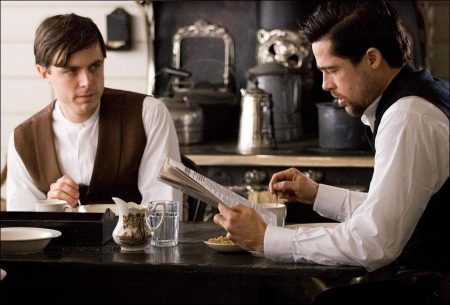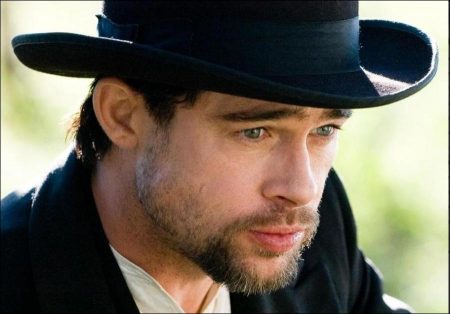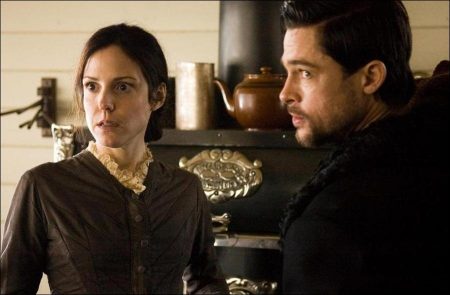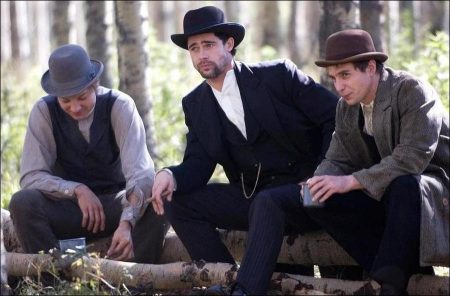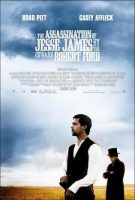Taglines: Beyond the myth lies America’s greatest betrayal.
Jesse James [Brad Pitt] was one of the country’s first bona fide celebrities. There have been countless books written and tales told about America’s most famous outlaw—all of them colorful and fascinating, all focused on his larger-than-life public persona and daring exploits, and most of them bearing only incidental reference to the truth. To those he robbed and terrorized, and to the families of those he admittedly killed, he may have been just a criminal, but in the sensational newspaper articles and dime novels chronicling the James Gang throughout the 1870s, Jesse was the object of awe and admiration.
He was a Robin Hood, they suggested, targeting railroad owners and banks that exploited poor farmers. He was a man with a tragic cause, a wronged and wounded Confederate soldier striking back against the Union that had ruined his life. Most importantly, to an increasingly buttoneddown and citified population leading ordinary lives, he was the last frontiersman—a symbol of freedom and the American spirit, a charismatic rebel who flouted the law and lived by his own rules…by all accounts, a legend. Foremost among his admirers was Robert Ford [Casey Affleck], an idealistic and ambitious young man who had devoted his life to the hope of one day riding alongside his idol.
He could never have imagined that history would ultimately mark him as the “the dirty little coward” who shot Jesse in the back. But who was Jesse James, really—behind the folklore and the selling of newspapers? And who was Robert Ford, just nineteen and a member of Jesse’s inner circle, who was able to bring down such a formidable figure when lawmen across ten states had tried and failed? How did they come to be friends and what happened between them in the days and hours leading up to the gunshot that would end one man’s life and become the definition and sum total of another’s? No one will ever know the whole truth.
Based on the novel by Ron Hansen, “The Assassination of Jesse James by the Coward Robert Ford” delves into the private lives of America’s most notorious outlaw and his unlikely assassin to offer a new perspective on a legend and address the question of what really may have transpired in the months before that infamous shooting.
About the Production
“Jesse James was bigger than you can imagine. You’d go to him, wanting to be with him, wanting to be like him…and you’d always come away missing something.” – Robert Ford
When writer/director Andrew Dominik read Ron Hansen’s novel The Assassination of Jesse James by the Coward Robert Ford, he was intrigued by some of the same questions that had guided Hansen’s years of research into previously unexplored corners of Jesse James’ life, and by the insights it offered into the private man behind the public image.
“I didn’t know any more about Jesse James or Robert Ford than the average person, but I was drawn into it as a story of people and emotions that were vivid and realistic,” he says. “Who are they? How do they feel? How do they interact with each other? The fact that they happened to be two legendary figures of American history added a level of drama but was really a secondary issue.
“This was a portrait of Robert Ford I had never seen before,” the director reveals. “It gives you a sense of what that event might actually have been like for him—to shoot a man in his own house with Jesse’s wife and children nearby and then to wait around for days with a brother who was completely unnerved, and try to deal with the enormity of public reaction. You see his anxiety, his neediness and his ambition and you think, ‘That’s probably what it was like.’ That’s what moved me about the book and what I wanted to capture on screen.”
Brad Pitt, who, in addition to taking on the leading role, is a producer on the film, found it equally compelling to address “the dissection of these myths, of Jesse James as a hero and Robert Ford as a coward.”
“The film offers an intimate portrait of these two men and the world around them that humanizes the legendary outlaw and exposes his vulnerability,” says producer Jules Daly. “Few people even know Robert Ford’s real story. For him, it was about a young man’s desperation to become everything he wasn’t and everything he worshipped.”
Though based upon comprehensive research into the principals, their history and the times in which they lived, the relationship between Jesse James and Robert Ford in the film is speculative and meant more to stir the imagination than impose a point of view.
Says producer Ridley Scott, “The universe of Robert Ford can only be imagined, as can Jesse James’ dilemma towards the end of his life, his private thoughts and possible regrets. The film raises questions best answered by each individual in the audience. Andrew poses the possibilities.”
Producer Dede Gardner adds, “The story is authentic in its examination of human behavior, adoration, ego and resentment. What happened between these two men could be applied to countless stories throughout time. The relationship between Jesse James and Robert Ford is about consequences and wishes fulfilled. It’s about how someone’s adoration for another has to be examined within the context of both their lives and individual needs. Hero worship cannot exist in purity. There are outside influences at work long before the two people in question even meet.”
“It’s more a psychological drama than a Western,” says Pitt. “It deals with the anatomy of an assassination and its consequences.” It’s this character-driven perspective that makes “The Assassination of Jesse James by the Coward Robert Ford” unlike many dramatizations about the notorious outlaw and his little-known killer. Although the action opens with a nighttime ambush and train robbery typical of the James Gang in their heyday, the real drama unfolds in the robbery’s aftermath—in Jesse’s personal demons, his intense dedication to covering his tracks and his increasingly cryptic interactions with the restless members of his gang who must sit idly by until he gives them word of their next job.
Following the robbery, Jesse breaks with his brother Frank, who feels the time has come to abandon the outlaw life for a safer existence elsewhere. Meanwhile, the price on Jesse’s head has grown to more than any of his gang could hope to make in multiple heists. What would prevent them from turning him in or putting a bullet into his head in exchange for their own safety and a hefty reward? Loyalty? Fear? More likely a little of both.
“One of the things I particularly like is how these characters struggle more with themselves than with each other,” Dominik observes. “Each is shaping reality to suit his desires and anxieties and they really do not connect with one another.”
Jesse James came to prominence at a time when the concept of media image was just developing. Publishers of newspapers and dime novels were catering to a public hungry for thrilling entertainment and Jesse James was made to order. Tales of his crimes were often enhanced and, when that wasn’t enough, fabricated from whole cloth with an emphasis on his daring and charisma. Such was the reading material Robert Ford grew up on, and that inspired his own grandiose dreams.
“It was fame and celebrity in the true sense of the word,” offers Scott. “But at that time there was a degree of simplicity attached to that kind of attention, even when applied to Jesse James and his notorious robberies. It became a romanticized vision, more hero and rebel than killer and criminal.”
Says author Ron Hansen, “In some ways he encapsulated American individualism, doing things that other people thought about but were too conventional to do. They wanted to wag a disapproving finger at him but at the same time were glad he was around to represent them. His image was partly due to the publicist he had in John Newman Edwards, a Kansas City newspaper editor. Whenever Jesse committed a crime, Edwards would tailor it to make him appear a dashing rogue or some kind of avenger striking a blow against all those interests that were supposedly impoverishing people in Missouri, when, in fact, it was Jesse James doing most of the impoverishing. Consequently, a real-life criminal became an action hero and, from that, the adulation followed.”
In contrast, Ford was diminished by history and the media—his existence reduced to a single purpose, as if echoing the sentiment on Jesse’s tombstone, “In loving memory of my beloved son, murdered by a traitor and coward whose name is not worthy to appear here.”
The irony is that Jesse James’ real personality needed no embellishment to fascinate: his unpredictable moods, his motives and complex interactions with the few people he considered confidants. Likewise, Robert Ford was a rich study, as was the relationship that developed, then deteriorated, between the two men.
“As I delved into it, I realized that no one had ever told the story of how Ford killed Jesse James in all its authentic detail, and it’s such an intricate drama,” says Hansen.
Following their introduction via Charley Ford and Robert’s successful debut as a member of the James Gang in the Blue Cut railroad job, Jesse enlisted Robert to help move his household to a new location, which was common practice for him after a high-profile robbery. Afterwards, his duty discharged, Ford stayed on as a houseguest, no doubt basking in the presence of his idol—and likely also beginning to see what he was really like.
Clearly, Jesse also saw something in his young admirer that made Ford worth having around. “Ford may have stirred the thought processes already turning around in his mind,” Scott suggests. “At the same time, Jesse must have recognized the hero worship aspect of Ford’s devotion as well as the inaccuracies and ironies that go hand in hand with that idea.”
“Perhaps Ford reminded Jesse of better times, or even of the ambition that he once had himself at that age,” adds Gardner.
Regarding the potential danger of inviting Ford into his home, Hansen believes the answer to that can be found in Jesse’s nature. “This was a man who robbed banks and trains; he liked being in situations where death was a possibility. He needed that rush. What he was doing with Robert Ford was like walking to the edge of a cliff and looking down.”
“It’s also possible,” posits Pitt, “that he was taunting Ford. It certainly is curious that he would remove his gun belt and turn his back. That action has led to much historical debate and speculation but remains ambiguous. With all his research, even Ron Hansen would say that there are questions that remain unanswered.”
As for what Ford was seeking from this man he’d spent his adolescent years admiring, the director says, “Robert is a person who seems easily hurt. He might have imagined that if he was with Jesse James—more to the point, if he was Jesse James—it would be a kind of armor that would protect him. We’ve all read about these cases. A person imagines himself having a special connection to someone, then discovers it’s not true, or it’s not enough. Adoration turns to anger. I think Ford’s feelings are always running side by side between the two emotions.”
“Ford’s transition from hero worshipper to assassin isn’t as drastic as the words may suggest, and this is one of the points of the film,” states Gardner. “Bob never contemplates the role his ego has in pursuing a friendship with Jesse. What he comes to realize is that, with Jesse in his life, there is too much Jesse and not enough Bob. In a petulant moment, he soars with the idea of being the man who will bring down this famous outlaw. Once he puts it into motion, it’s all he can do to keep up; it’s eternally more than he bargained for or could ever fathom.”
In the final analysis, there were myriad factors contributing to Robert Ford’s decision to kill Jesse James, not the least of which were the very practical considerations of self-defense and the reward money. Added to the mix, Daly counts, could have been “fear, fate, envy, disappointment and the irresistible opportunity to be ‘great’ and to matter. In some ways, their bond was like destiny. It was as if Jesse chose Robert Ford as much as Ford chose him.”
But even as he delivers the fatal shot, and long afterwards, Daly says, “Ford’s position never shifts from hero worship. He never stops admiring Jesse.”
“In the end, I believe it’s a case of more tears being shed for answered prayers,” offers Dominik. “Robert Ford gets what he wants and achieves a certain amount of fame and notoriety but finds it’s not as he imagined…much like Jesse James and the life he led might not have been quite as Jesse imagined, either.”
Capturing Both the Exterior and Interior Landscape
To suit the story and its historic, often majestic locales, the filmmakers sought to create a look “both austere and sumptuous,” says Pitt. They enlisted renowned cinematographer and five-time Oscar nominee Roger Deakins, who says, “This is one of the most atmospheric films I’ve ever worked on. It’s based on a book of poetic lyricism with moments of deep melancholy, and we worked to bring this feeling to the movie. It’s visually different from the Westerns one is used to seeing. The country was changing during this period and we wanted to reflect that.”
“It was more Victorian and post-Civil War than frontier,” Dominik explains, citing that the creative team avoided iconic images of Western movies that would have been inauthentic.
“There were no cowboy hats. The gun Jesse gives Robert has a bakelite handle, which looks quite modern. The truth is, it’s not the Old West, it’s not the frontier; they live in Kansas City and St. Joseph, Missouri, both of which were hubs at the time. It’s the 1880s. The telephone had just been invented.”
Deakins’ camerawork on “The Assassination of Jesse James by the Coward Robert Ford” occasionally offers glimpses of life seen through the flawed and rippled glass that was typical of the time. In one scene, Robert Ford, while a guest at the James household, intently and surreptitiously studies Jesse at his leisure in the yard through a back window.
Says Deakins, “It’s in some ways a story about the transitory nature of reality. It’s a movie about surfaces. What we see and what we react to in life are surfaces only.”, perhaps from hell,”
Deakins remarks. “It’s as if Jesse is a ghost already. Things like glass and steam make things seem as if they’re not quite solid and convey the feeling that everything is a reflection.” Later, the cinematographer’s wide angle captures the outlaw standing alone in a field—a small figure in a vast landscape, the opposite of his larger-than-life image—indicating, “how humans are just a small part of nature, despite our feelings of importance.”
The filmmakers found the open spaces they needed in the prairies and McKinnon Flats region of Southern Alberta, as well as various other locations in Canada, where seemingly uninhabited expanses retain much of their original character and made them an excellent choice to double for territories like Kansas, Kentucky, Missouri and Colorado, circa 1881.
Fort Edmonton and Calgary’s Heritage Park are tourist parks built from authentic period architecture collected from small towns across the country, providing a perfect location for the Jesse James story. Says producer David Valdes, “Andrew loved it. This assemblage of historic buildings were exactly what we were looking for and eliminated the need for us to construct an entire town.”
Filming at Fort Edmonton offered the bonus of a working railroad line and vintage train for the film’s dramatic Blue Cut robbery sequence. Valdes, whose production credits include “Pale Rider,” “Unforgiven” and “Open Range,” admits, “Any time you have a scene with a period train, you have massive logistical problems because there are very few private lines with antique trains. You can find old steam engines and train cars from collectors or museums, but transporting them on a flatbed to a track in an appropriate setting is an ordeal. If it’s a live track you’re restricted on time and availability. The beauty of Fort Edmonton is that they have a vintage train plus sufficient length of track devoted to it, and it passes through a varying terrain.”
In a friendly exchange, filming left the tourist attraction’s train “in more authentic period shape than when we arrived,” Valdes says. “We re-painted it, installed sleepers and added a baggage car, all to historical accuracy.”
The crew then recreated snowbound Creede, Colorado, in Calgary at Goat Creek, in the Kananaskis Provincial Park, where the weather was brisk—to put it lightly. Casey Affleck, born in Boston and no stranger to single-digit temperatures, had to admit this was a new level of cold, joking that the northern locale was “like an Arctic blast, every morning and night. Good thing that long johns were part of the period wardrobe. I could have layered 15 pairs.”
Following that location shoot, the production recycled their materials via local projects, mostly in the nearby town of Canmore. Tents were given to a local outfitter who provides fishing tours to the Rockies, and the owner of the Crazy Weed Café incorporated pieces of trestle into his new restaurant, prompting Valdes to observe, “Creede lives on in Canmore.”
Horse Wrangling and Gun Slinging
For the James Gang, riding was as natural as walking but that was not entirely the case for the film’s cast, who received two weeks of on-the-job training in the fine art of horsemanship. Avowed “city boy” and first-time rider Sam Rockwell explains with a laugh, “You just can’t look like a jerk on a horse. You have to look like you’ve been riding all your life. I wasn’t sure what to expect but I finally figured it out: mostly it’s trying to keep your butt on the saddle and not bouncing around too much.”
With Rockwell representing one extreme and seasoned rider Jeremy Renner representing the other, the cast brought their various degrees of expertise and trained together, generating a lot of humor. Says Renner, “I hear Rockwell has a horse ring tone on his phone now.”
Head Wrangler John Scott, who taught Brad Pitt to ride for his Golden Globe-nominated role in 1994’s “Legends of the Fall,” notes that the actor “picked it up again quickly, although he hasn’t ridden a horse since that production wrapped. I believe motorcycles are more his speed.”
A third-generation horse trainer and former rodeo rider, Scott supervised the acquisition and care of 80 animals on set, which he classifies as “saddle horses, buggy horses, carriage horses or cast horses, chosen primarily for temperament. The James Gang would have ridden thoroughbreds for the most part because they’re fast and these guys were always on the fly.”
Additionally, Scott acquired vintage buggies and carriages, some of which are genuine models dating as far back as 1875, plus replicas and some hybrids made of modern seats reconstructed atop original steel foundations.
The cast received firearms training courtesy of renowned Hollywood gun coach Thell Reed (“Mr. & Mrs. Smith,” “Deadwood”), to get comfortable with the weight and trigger action of their period six shooters and rifles. The exception was Schneider, who jokes, “My character, Dick Liddil, isn’t supposed to be particularly good at weapons. I figured he would be grabbing for his comb a lot quicker than his gun, so I didn’t pay a lot of attention during the weapons training. I tried hard not to listen.”
It’s in the Details
In cases where mythology conflicted with history, firearms were selected in line with the preponderance of evidence. The gun Robert Ford used to shoot Jesse James, for example, has been alternately reported as a Smith & Wesson Model 3 American or a .36 caliber, and the filmmakers opted for the Model 3, a nickel-plated pistol that fired .44 rounds. It took some effort to track down the rare collectors’ item, as well as a similar Schofield Model 3 used by Jesse James. Only a few were located, and in poor condition, but they were subsequently rebuilt by Smith & Wesson and, in the case of the gun carried on screen by Pitt, marked with the actual serial number of the one once owned by Jesse James.
As both actor and producer, Brad Pitt gave a tremendous amount of attention to the authenticity of props, in particular those pertaining to Jesse, to the extent of having Jesse’s mark inscribed inside the silver pinky ring the outlaw wore to show allegiance to his former Civil War guerilla brigade, Quantrill’s Raiders. A gold ring reportedly found on Jesse’s body was inscribed with his full name, and that was likewise reproduced for the actor to wear, even though the audience will never see it.
Says property master Dean Goodine, “He had a lot of influence and input. Whether the audience is aware of something or not, was not as important as it was to Brad, himself, that it’s genuine. We worked very hard at being realistic; we really went deep on this one.”
As Jesse James was known for keeping abreast of current events and always read the local papers, even going so far as to write the editors to correct errors in their reporting of his crimes or to amplify and dramatize his role, all newsprint pages seen on screen are faithful reproductions. Dime novels chronicling the largely fabricated exploits of the famous outlaw were recreated for Robert Ford’s shoebox collection of memorabilia about his idol, as were certificates for the Chicago Alton Railway, plus period currency.
For the various photographs featured in the film, most notably shots of Jesse’s body that were later circulated as $2.00 prints or seen in stereoscopic viewers at drugstores across the country, production eschewed computerized techniques and instead hired experts in historic glass plate and tin plate photography to apply the genuine process.
Such commitment to detail, in Dominik’s view, “is so appropriate, considering that our goal was to tell this story and present these characters in as authentic a way as possible. There are elements in the film that aren’t critical to the story but add to the overall sense that what we’re doing is complete. It’s the difference between building a set or creating a world.”
The Assassination of Jesse James by the Coward Robert Ford (2007)
Directed by: Andrew Dominik
Starring: Brad Pitt, Casey Affleck, Sam Shepard, Mary-Louise Parker, Jeremy Renner, Paul Schneider, Sam Rockwell, Zooey Deschanel, James Defelice, Catherine Gell
Screenplay by: Ron Hansen
Production Design by: Richard Hoover, Patricia Norris
Cinematography by: Roger Deakins
Film Editing by: Curtiss Clayton, Dylan Tichenor
Costume Design by: Patricia Norris
Set Decoration by: Janice Blackie-Goodine
Art Direction by: Troy Sizemore
Music by: Nick Cave, Warren Ellis
MPAA Rating: R for some strong violence and brief sexual references.
Distributed by: Warner Bros. Pictures
Release Date: September 21, 2007
Visits: 65
